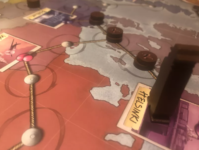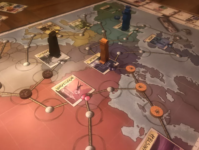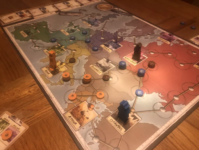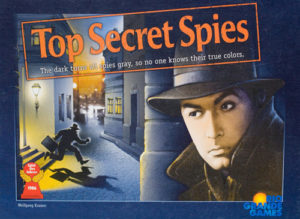- Learning time
- 20 minutes
- First play time
- 60 minutes
Spy Connection
Designed by: Brett J. Gilbert,Matthew Dunstan
Spy Connection is a game of making connections: of moving your spy around the map to specific destinations in order to complete missions, for points.
You can do two things on your turn: pick up a mission card from the display – you can have multiple missions on the go – or expand your network/move your spy. There’s a big wooden piece on the map – your spy – and lots of little discs – your agents – that have several uses, but the main one is establishing connections between cities. Note that connections between cities can be shared by multiple players, but it’s cheaper for the first player to make the connection, as they only need one agent for every step on the route. If there are already agents there, you need to place two instead.
If you take this second option, you may first move your spy to any city on your network, then use your agents to establish a network to a new city from the one your spy is in, and move your spy to that new city. As your spy travels from city to city, your agents are also used to check off destinations on your mission cards, which each need a number of agents assigned before the mission itself is complete, and all the agents are back at your disposal.
Some mission cards also require the ‘payment’ of agents to take them, you often find there’s never enough agents to do all the things you want to do. The solution is at your fingertips: any of your own agents can be withdrawn from the board (very likely!) or abandoned from missions (less so) at any time on your turn, to be assigned new jobs. The catch is that reassigning them obviously breaks up your established network, and so you are constantly managing your agents in service of your spy, in service of your missions, in order to complete them for points.
When any one player has completed seven missions in total, the game ends and the player with the most points is the winner.
The guru's verdict
-
Take That!
Take That!
Not a huge amount of direct interaction, but the nabbing of missions and routes can certainly play a role in the success or otherwise of everyone at the table.
-
Fidget Factor!
Fidget Factor!
Low! Although the game can occasionally hit a lull when someone needs to consider their options, the vast majority of turns move quickly.
-
Brain Burn!
Brain Burn!
Your goal is to complete missions, and often the best way to do that suggests itself. However on some turns the game asks a bit more of you - particularly at higher player counts, when the board gets busier.
-
Again Again!
Again Again!
If it doesn't quite bulge with variety, it's never 'solved' either, and lands at a nice compromise between rules, decisions, and breezy playtime.













Sam says
A sweet little family game that seems marginally opaque on first play - how connections are made, the spy moving completing missions, managing your finite amount of agents - but swims into focus very quickly. It doesn't do anything hugely dramatic, or clandestine-feeling, but it does the things it does competently enough; building routes, completing them, managing resources. The overlap of interests and needs with players needing to share routes or avoid each other is very neat, and prevents Spy Connection from feeling rote. Not spectacular then, but a pleasant and engaging half-hour or your time.